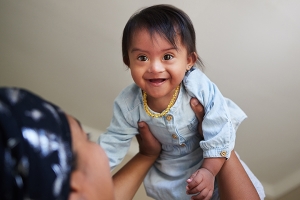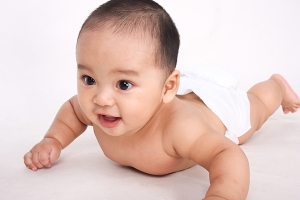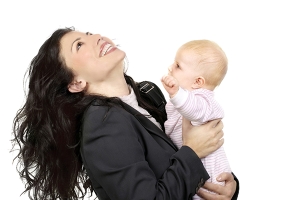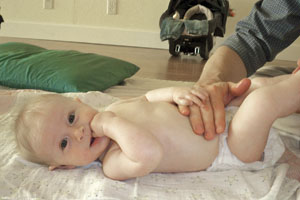
Baby massage offers a simple and relaxing way to enhance the health of infants and parents. It also provides a special time to strengthen these new relationships.
“Touch is a baby’s first language, so using massage is an effective tool to communicate love and caring to your newborn,” says Amy Marsolek, a certified massage therapist, who specializes in baby massage. “When you’re giving your baby a massage, you’re doing something nice for them. Many parents worry so much about giving material items to their children. A massage is priceless. It’s spending good, quality time with your baby.”
Baby massage, which releases those feel-good hormones known as endorphins, brings a sense of general relaxation for an infant. In turn, this helps to promote good health and more sound sleep.
“Giving your baby a massage is relaxing for parents too,” Marsolek says. “When you’ve been gone to work all day, you don’t want to just sit in front of the TV with your baby.”
Massage, especially on the stomach area, is known to ease symptoms of gas and colic (acute abdominal pain) for babies. It also improves circulation, because it increases blood flow throughout the body, Marsolek says. Massage performed gently upon the baby’s sinus area can help to relieve stuffiness with allergies and colds, she says.
Debbie Hosch turned to baby massage when her daughter was about 2 months old. “It was hard to get Rachel to settle down,” Hosch says. “She wasn’t colicky, but she definitely had her ornery times.”
Hosch learned from Marsolek that the soothing touch of massage could assist Rachel to calm herself. “It certainly helped her to fall asleep better,” Hosch says. “It was amazing.”
Baby massage upon Rachel’s stomach area also helped her to have regular bowel movements. “After having a massage, my baby didn’t seem to have as much gas and she was in a better mood,” Hosch says.
Baby Massage Basics
Baby massage is easy to learn. Follow these basic tips from Marsolek for a happy baby massage:
Begin by saying to your baby that you’re giving her a massage. Tell her what you’re doing. Just as you use other words to teach your baby about the world, the word “massage” shouldn’t be any different. The baby will begin to associate massage with a quiet, peaceful time.
Create a peaceful atmosphere. To help make this positive association, avoid massaging your baby when she’s fussy. You want her to relate massage with a calming environment, such after a bath or a feeding or right before bedtime. One idea to create a tranquil environment is to arrange her familiar stuffed animals and toys around the massage area.
Calm yourself first. Make sure you’re not feeling frustrated or stressed when you’re giving an infant massage. Babies will really read this in your touch and in the pressure of your hands. You want to give a massage on a day when you’re feeling okay with yourself.
Think soft and warm. Gently place the baby on their back on a soft surface, such as on a blanket, on your bed, or on your lap—whatever is comfortable for you. Depending on the room temperature, the child can be massaged with little or no clothing on, but you do want her to be kept warm.
Find a good position. As a baby grows, you can change the position you massage her in. After about six months, for instance, you can massage her feet, legs and other areas while she’s sitting up. You can modify the position as she grows older; you don’t need to be stuck in one position.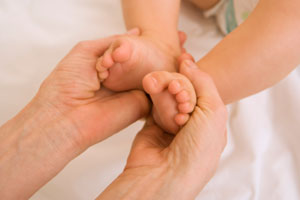 Use circular and/or upward motions. Start by massaging the infant’s legs and feet. You can use baby lotion or baby oil that you already use on your baby at home. Along with circular motions, you also may try upward, gentle movements with your hands on baby’s skin.
Use circular and/or upward motions. Start by massaging the infant’s legs and feet. You can use baby lotion or baby oil that you already use on your baby at home. Along with circular motions, you also may try upward, gentle movements with your hands on baby’s skin.
Using these motions, whole body massages can include her stomach, legs, arms, back, chest, face, scalp and ears. You do not need to do full body massages every time.
Follow baby’s cues. Depending on the baby’s mood and how they’re tolerating the massage, a parent may only massage the baby’s lower body.
Parents need to gauge their baby’s reaction to determine the length, anywhere from five to 20 minutes, and areas the massage will cover. This will vary day to day. Each baby will determine an appropriate amount of time. Watch their cues for the time that is right. In addition, observe their cues whether they’re smiling, cooing and talking, signaling contentment.
No crying allowed. A baby shouldn’t be crying during her massage. If your baby starts to cry during the massage, attend to their needs if she needs to be fed or changed. Then, if she seems receptive to continuing the massage, do continue. If not, massage at another time.
Avoid pressure. If the infant’s skin turns red during the massage, you’re using too much pressure or you need to use more lotion or oil.
Multi-task. Massage doesn’t need to be an activity done on its own. You can name the body parts you’re massaging to start teaching her words about herself. You can massage your infant while you’re reading to them. This allows both mom and dad to get involved in the baby’s massage. One parent can hold the baby and massage, and another parent can read to her.
Take a class. Although you can give your infant a massage with no formal training, Marsolek recommends that parents take a baby massage class by a certified instructor, if it’s available in your community. “You can learn different techniques to help you feel comfortable massaging your baby,” she says. “You’ll learn about a great gift that you can give them with love—massage.”
Kim Seidel is a freelance writer.








